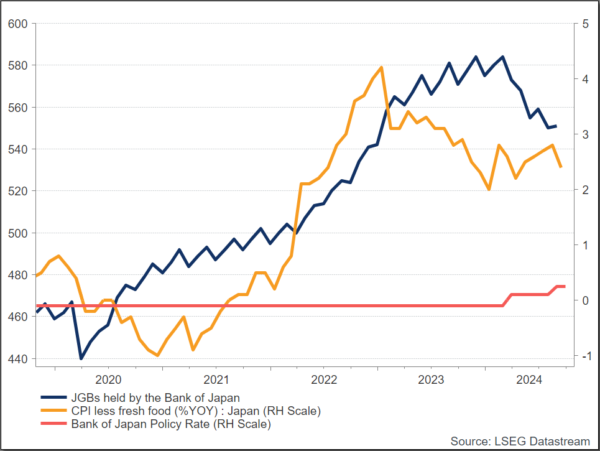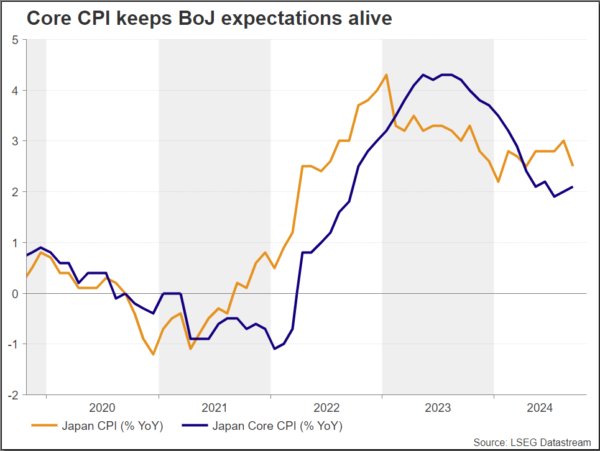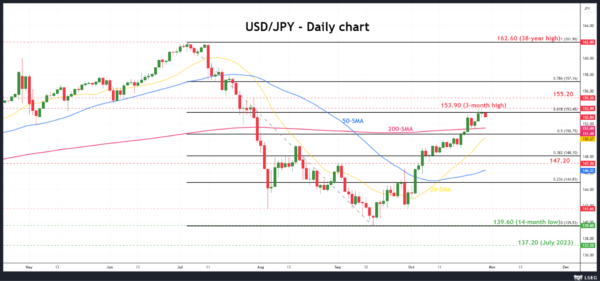- BoJ expected to leave rates at 0.25%
- Lowest inflation since April at 2.5%
- Yen dives to new 3-month low
- Decision comes out on Thursday at 03:00 GMT
BoJ to leave rates unchanged
The Bank of Japan (BoJ) is anticipated to maintain its existing interest rates during the policy meeting on October 31. This decision reflects Governor Kazuo Ueda’s prudent strategy, highlighting the necessity to evaluate risks, especially those associated with the US economy and fluctuating markets. The Bank of Japan earlier terminated its negative interest rate policy in March and elevated its short-term policy target to 0.25% in July. Nonetheless, with inflation consistently near 2% and no imminent indications of escalation, the BoJ is not hastening to execute any rate increases.
Quarterly report
The Bank of Japan’s quarterly report, which will feature updated GDP and inflation projections, is expected to offer insights into the timing of forthcoming interest rate increases. Analysts anticipate that the BoJ will emphasize risks, including sluggish global growth and market volatility, which may reduce the probability of a year-end rate increase. The post-meeting briefing by Governor Ueda will be scrutinized for indications concerning the speed and timing of forthcoming interest rate increases.
Inflation
As of September, Japan’s annual inflation rate is 2.5%, a decrease from 3.0% in the preceding month. This signifies the lowest inflation rate since April. The decline is ascribed to subdued rises in electricity and gas prices, together with tempered expenses for food, furnishings, transportation, and cultural activities.
Japan’s inflation rate has been comparatively low in relation to other G7 nations, attributable in part to government-imposed price controls, an elderly demographic, and negative interest rates. These elements have contributed to maintaining inflation stability amid global economic pressures.
Recent Elections and Political Landscape
The general election held on October 27, caused a notable transformation in Japan’s political landscape. Prime Minister Shigeru Ishiba’s governing coalition lost its majority in the lower chamber for the first time in 15 years. This loss has generated political uncertainty, hindering attempts to retract monetary stimulus. The election outcomes have compelled the ruling Liberal Democratic Party (LDP) to pursue coalitions with minor opposition parties to establish a government.
Economic Outlook for 2025
The economic forecast for Japan in 2025 is cautiously hopeful, as the International Monetary Fund (IMF) anticipates a small recovery fueled by growing real earnings and heightened consumption. Notwithstanding obstacles including supply chain interruptions and a waning influx from tourism, economic growth is anticipated. Important factors influencing this outlook include the anticipated increase in wages, which will boost household purchasing power and domestic demand, as well as the Bank of Japan’s likely continuation of policy normalization, potentially leading to further interest rate hikes. Although headline inflation is anticipated to decelerate, core inflation may continue to be bolstered by increased wage growth. Moreover, political stability will be crucial, as prospective leadership changes may influence economic policies and investor confidence. Japan is shifting from stagnation to modest growth, helped by structural reforms and policy modifications.
Yen remains under pressure
If the BoJ sustains its current interest rates, as anticipated, the yen may not experience substantial immediate fluctuations. Any indications of impending rate increases may bolster the yen as investors foresee enhanced profits on yen-denominated assets. The yen has lost more than 10% versus the dollar over the last one-and-a-half months.
The dollar/yen is holding slightly beneath the three-month high of 153.90 with strong resistance near the 61.8% Fibonacci retracement level of the down leg from 161.94 to 139.60 at 153.40. More gains could lead the market toward the 155.20 bar. Otherwise, a move south may drive the market toward the 200-day simple moving average (SMA) at 151.50.
Since there are no signs of raising interest rates any time soon, the yen will likely keep falling against the dollar. However, if the yen’s value continues to decline, officials are likely to hike interest rates sooner rather than later.
















